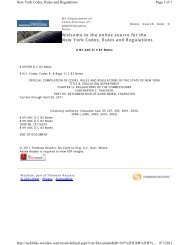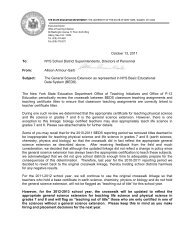ESL Learning Standards - Higher Ed - New York State Education ...
ESL Learning Standards - Higher Ed - New York State Education ...
ESL Learning Standards - Higher Ed - New York State Education ...
You also want an ePaper? Increase the reach of your titles
YUMPU automatically turns print PDFs into web optimized ePapers that Google loves.
<strong>ESL</strong><br />
5<br />
Standard<br />
5:<br />
Students will demonstrate cross-cultural knowledge and<br />
understanding.<br />
Performance indicators by grade level:<br />
Early Childhood (Pre-K – 1) Elementary (2 – 4)<br />
1. Demonstrate familiarity with some cultural and language<br />
patterns and norms in American English.<br />
Such patterns and norms include levels of formality,<br />
idioms, and humor.<br />
(L, S, R)<br />
1. Demonstrate familiarity with cultural and language patterns<br />
and norms in American English.<br />
Such patterns and norms levels of formality, slang,<br />
humor, idioms, and rhetorical patterns.<br />
(L, S, R, W)<br />
2. Demonstrate familiarity with some U.S. cultural referents<br />
at the local and national levels.<br />
Such cultural referents include holidays, symbols, traditions,<br />
and customs.<br />
(L, S, R)<br />
2. Demonstrate familiarity with a broad range of U.S. cultural<br />
and political referents through institutions, functions,<br />
and processes at the local and national levels.<br />
Such cultural and political referents include holidays,<br />
symbols, traditions, customs, governance systems, and<br />
schooling.<br />
(L, S, R, W)<br />
3. Share cross-cultural experiences and ideas with others.<br />
(L, S, R, W)<br />
4. Interpret and demonstrate knowledge of nonverbal<br />
communication, and understand the contexts in which<br />
they are used appropriately.<br />
Such means of nonverbal communication include gestures,<br />
body language, volume, and stress.<br />
(L, S,)<br />
3. Recognize and share cross-cultural experiences, and<br />
ideas, and connect with those of others.<br />
(L, S, R, W)<br />
4. Interpret and demonstrate knowledge of nonverbal and<br />
oral communication features, and understand the contexts<br />
in which they are used appropriately.<br />
Such features include gestures, body language, volume,<br />
stress, and intonation.<br />
(L, S)<br />
5. Read, listen to, and respond to myths, folktales, and literature<br />
from the United <strong>State</strong>s and international regions<br />
and cultures, including the students’ own.<br />
(L, S, R, W)<br />
5. Read, listen to, and discuss myths, folktales, and literature<br />
from the United <strong>State</strong>s and international regions<br />
and cultures, including the students’ own, and identify<br />
similarities and differences among them.<br />
(L, S, R, W)<br />
6. Learn about and demonstrate an appreciation of some<br />
commonalities and distinctions across cultures and generations,<br />
including the students’ own.<br />
(L, S, R, W)<br />
6. Recognize and demonstrate an appreciation of some<br />
commonalities and distinctions across cultures and<br />
groups (differentiated by gender, ability, generations,<br />
etc.) including the students’ own.<br />
(L, S, R, W)<br />
Listening (L) Speaking (S) Reading (R) Writing (W)<br />
28 <strong>Learning</strong> <strong>Standards</strong> for <strong>ESL</strong>
















